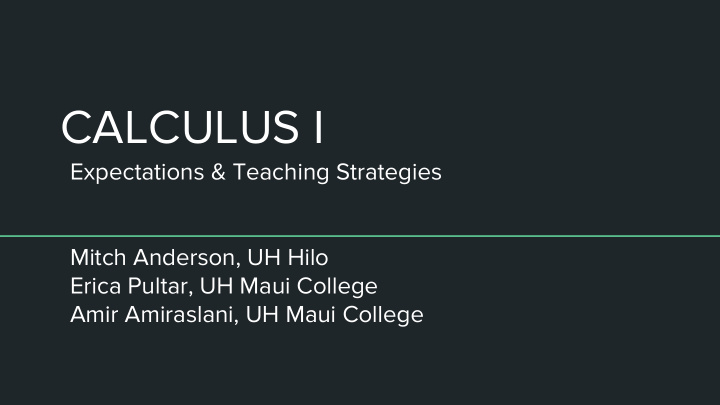



CALCULUS I Expectations & Teaching Strategies Mitch Anderson, UH Hilo Erica Pultar, UH Maui College Amir Amiraslani, UH Maui College
Student Expectations for entering Calculus I 1. Algebra Fluency - Be able to show the domain of an expression using interval notation and when necessary find the intersection of intervals - Be able to find the common denominator of symbolic expressions with fractions - Be able to factor expressions using basic identities such as binomial identities - Be able to rationalize expressions including radicals when necessary - Be able to simplify radical expressions and use absolute value when necessary
Student Expectations for entering Calculus I 2. Function Fluency - Families of Functions - Recognize polynomial, rational, power (square/cube root), exponential, log/ln, and trig functions, both from symbolic and graphical representations - Recognize and be able to apply the types of algebraic manipulations you would expect to be able to perform for each, and know when a computer is more appropriate - Interpret function notation in conceptual context - E.g. By properly interpreting the numerator of [f(x + h) - f(x)]/h, conclude this represents a secant line slope, or average rate of change of f over the interval [x, x + h] - Interpret functions defined recursively: f(x + 1) = c f(x) and f(x + 1) = f(x) + c simply say respectively that the “next” output is a constant multiplied by the “current” output, and the “next” output is the “current” output plus a constant, which are the primary definitions of exponential and linear functions
Student Expectations for entering Calculus I 3. Conceptual Fluency - Intellectual maturity and sophistication appropriate to the level of the course - Function fluency assists this process - Ability to go beyond following an algorithmic process: e.g. being able to get information off a graph helps students gain a deeper understanding of the symbolic representations - Ability to intellectualize higher order concepts
Teaching Strategies The Problem Solving Rubric What is the problem to be solved? ➔ e.g. Define instantaneous velocity ◆ What high school formula would you normally use to solve this type of problem? ➔ r =d/t ◆ Why can’t you use this formula directly? ➔ ◆ Change in time cannot equal zero (can’t divide by zero) What is your strategy for overcoming this difficulty? ➔ Approximate ◆ Take better and better approximations and look for convergence ◆
Teaching Strategies - The Limit Concept Not a discrete topic: Limits permeate most of Calculus 1 and 2 ➔ Problem: How to train students to think deeply about limits ➔ Hands on: they need to visualize the limit process ◆ Appropriate Tools: Graphing calculators and computers ◆ Graphing Calculator Example: Slope at x = 3, begin with h = .1 and -.1 ➔ h = .1 h = -.1 6.1 5.9 6.05 5.95 6.025 5.975 6.0125 5.9875 6.00625 5.99375
Teaching Strategies - Precise Conditioning Program The Definite Integral Arc Length Euler’s Method x^ln(x) from 1 to 3 sin(x) from 0 to 1 dy/dx = xy, y(0) = 1 n L(n) n L(n) n L(n) 10 3.364598787 10 1.311382031 10 1.547110398 100 3.567427475 100 1.311441892 100 1.637820458 1000 3.588436089 1000 1.311442492 1000 1.647623038 10000 3.590544223 10000 1.311442498 10000 1.648611365 100000 3.590755109 3.590778541 1.311442498 1.648721271
Teaching Strategies - Assessment How do we know they truly understand the concepts? Answer: Group Projects 1. The Derivative: Sin Gun - How fast is the bullet traveling when it hits? (Intuitive Parametric Function) 2. Integration as a Process: The River Skipper - How long does it take the boat to arrive, if the current is determined by position (as opposed to time)? ODE 3. Integration as a Process: George the Slug - Where is George 5 minutes later, if his direction and speed are determined by his position? 2-dim Differential Equation. Note: We don’t cover differential equations until AFTER the two group projects. Students independently discover Euler’s Method in 2-dimensions.
Teaching Strategies - Group Labs My goals for group labs: - Offer a hands on activity besides lecture - Incorporate technology - Schedule some lecture time in a computer lab - I’ve been utilizing free online graphing calculator www.desmos.com - Want students to make visual connections to topics - Want students to experience very light computer programming - Get students to talk to each other. - Make conjectures, challenge each other, etc. - Get students to support and justify their hypotheses using precise language
Teaching Strategies - Group Labs Version 1 In this version, students are building the graphs they need to answer questions. Plan these activities before the topics are formally introduced in lecture Example 1: Zooming to find Derivatives
Teaching Strategies - Group Labs Version 1 Example 2: Function & Derivative Relationship
Teaching Strategies - Group Labs Version 2 In this version, I give students pre-made graphs/programs to use and analyze. Example 3: Epsilon-Delta Relationship
Teaching Strategies - Group Labs Version 2 Example 4: Newton’s Method
Thoughts ● Want students to feel comfortable in this part of class Writing thought-provoking questions/prompts is hard ● ● Planning is important
Teaching Strategies- Adding a group project component - Projects about real-life applications of one or more major topics covered in the course assigned within the first four weeks of class (10% of the total grade) - A presentation rubric and a scientific report rubric provided - Group presentations and reports at the end of the semester - Could lead to a problem-based learning approach to calculus in the future Examples: - Can the sun become a black hole? - Optimally designing a tent -
Common Themes ● Technology Group work ● ● Making deeper connections with material, not just memorizing rules ● Using both precise math and English to explain or justify answers
Q & A
Recommend
More recommend